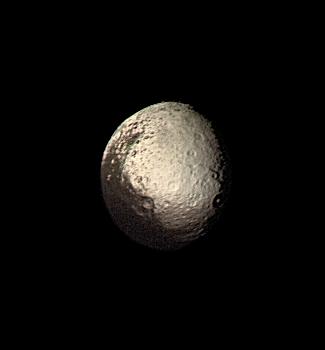
Iapetus Bright and Dark Terrains
Saturn's outermost large moon, Iapetus, has a bright, heavily cratered icy terrain and a dark terrain, as shown in this Voyager 2 image taken on August 22, 1981. Amazingly, the dark material covers precisely the side of Iapetus that leads in the direction of orbital motion around Saturn (except for the poles), whereas the bright material occurs on the trailing hemisphere and at the poles. The bright terrain is made of dirty ice, and the dark terrain is surfaced by carbonaceous molecules, according to measurements made with Earth-based telescopes. Iapetus' dark hemisphere has been likened to tar or asphalt and is so dark that no details within this terrain were visible to Voyager 2. The bright icy hemisphere, likened to dirty snow, shows many large impact craters.
